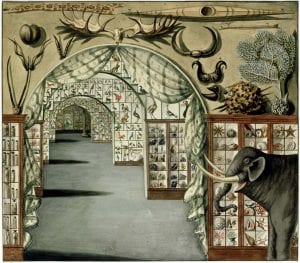The Stories Behind Objects
By Hannah L Wills, on 14 February 2017
By Hannah Wills
During my most recent engagement session at the Petrie Museum, I got the chance to take a look at their new exhibition ‘Exporting Egypt: Where? Why? Whose?’. This fascinating exhibition charts the journeys of some of the objects from British excavations in Egypt, conducted between the 1880s and 1980s, following these objects from the sites where they were found, to institutions around the globe. As this exhibition reveals, each and every object we encounter in a museum has a history, a past life, shaped by the circumstances of its acquisition, and an often complex mesh of politics, agendas and negotiations.
Taking a look around the exhibition got me thinking about my own research, which examines the work of Charles Blagden (1748-1820), secretary to the Royal Society under the presidency of Joseph Banks (1743-1820). Joseph Banks made his name by taking part in Captain James Cook’s first voyage aboard HMS Endeavour, which lasted from 1768 until 1771, visiting Brazil, Tahiti, New Zealand and Australia. During the voyage, Banks and his team, comprised of naturalists and artists, collected specimens including fish, crustaceans, birds and plants, which were described and preserved on board the ship. These collections, when they returned to England, were taken directly to Banks’s own home in New Burlington Street, and were to form the basis of his own collection later stored in his residence at 32 Soho Square.[i]
Having made his name on board the Endeavour voyage, Banks also played a central role in organising other expeditions, providing specific instructions for what was to be collected. Cook’s subsequent two voyages resulted in the collection of many more specimens, which, despite Banks not participating directly in the voyages, all passed through Banks as a kind of ‘hub’ for the dispersal of material. These specimens were subsequently to end up in institutions such as the Royal College of Surgeons, the Linnean Society and the British Museum.[ii]
Charles Blagden, the key figure in my research, also collected natural history specimens, which, as the historian Reginald Howe has suggested, may also have ended up in the British Museum. Whilst serving as a surgeon aboard a hospital ship during the American War of Independence, Blagden was asked to collect a number of specimens from America for his friend and fellow naturalist Daines Barrington, to be given to his friend Sir Ashton Lever for display in his museum.[iii] Perhaps not wanting to slight his friend and patron Joseph Banks, Blagden decided to send his collection, comprised of preserved animals collected from Rhode Island, jointly to both Barrington and Banks. The specimens, preserved in kegs of rum and transported aboard the Brigantine Betsy, a navy victualing ship, were to be shared “six kegs apiece” between the two men, and either kept or disposed of as each saw fit.[iv]

Perspective interior view of Sir Ashton Lever’s Museum in Leicester Square, London, March 30 1785. Watercolour by Sarah Stone. Photo credit: State Library of New South Wales.
Some of the ways in which animal specimens made it back to Britain from far-flung shores in the eighteenth century are described in the Short directions for collecting, preserving and transporting, all kinds of natural history curiosities, published by the naturalist Johann Reinhold Forster in 1771. “All Quadrupeds of a great bulk”, Forster wrote, were to be “skinned” and “washed or brushed over with a liquor” made of Sal Ammoniac (ammonium chloride), water and mercury, before a complex procedure of stuffing and drying. “Small Quadrupeds”, on the other hand, were to be “plunged into a keg of brandy, rack or rum, and thus sent over”. For birds, to be prepared in a similar way, Forster was keen to note that the shot used to kill the animal should be “proportioned to their size”, and that “Young birds… must not be taken”.[v]
The Petrie Museum’s new exhibition is great for getting visitors to think about questions of ownership, collecting and transport—the things that I’ll often forget about as I wander through a museum admiring beautiful or intriguing objects. In the Grant Museum too, it can be easy to forget that each and every specimen has its own journey, a story to tell about who collected it and why, as well as the more gruesome tale of its preparation, storage and transport. The historian Samuel Alberti has written about the notion of object biographies in relation to museum artefacts, arguing that museums serve as a “vessel for the bundle of relationships enacted through each of the thousands of specimens on display and in store”.[vi] But the story of the object does not end when it enters the collection, as Alberti notes. As viewers we react to objects in a range of different ways, according to our memories, associations, and feelings.[vii] By hearing the reactions of visitors in UCL’s museums, I enjoy seeing how these ‘object stories’ continue to develop.
‘Exporting Egypt: where, why, whose?’ is on at the Petrie Museum from Tuesday 31 January to Saturday 29 April 2017, Tues-Sat 1-5pm.
[i] David Philip Miller, “Joseph Banks, Empire and ‘Centres of Calculation’ in Late Hanoverian London,” in Visions of Empire : Voyages, Botany, and Representations of Nature, ed. David Philip Miller and Peter Hanns Reill (Cambridge and New York: Cambridge University Press, 1996), 27.
[ii] Ibid., 29-30.
[iii] Reginald Heber Howe, “Sir Charles Blagden, Earliest of Rhode Island Ornithologists,” The American Naturalist 39, no. 462 (1905), 398.
[iv] Letter from Charles Blagden to Joseph Banks, 28 Oct 1777, quoted in Howe “Sir Charles Blagden”, 398.
[v] Johann Reinhold Forster, A Catalogue of the Animals of North America. Containing, an Enumeration of the Known Quadrupeds, Birds, Reptiles, Fish, Insects, Crustaceous and Testaceous Animals; Many of Which Are New, and Never Described Before. To Which Are Added, Short Directions for Collecting, Preserving, and Transporting, All Kinds of Natural History Curiosities (London: B. White, 1771), 35-37.
[vi] Samuel Alberti, “Objects and the Museum,” Isis 96, no. 4 (2005): 561.
[vii] Ibid., 569.
 Close
Close



